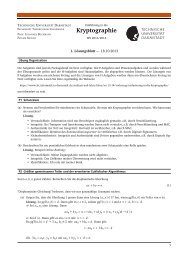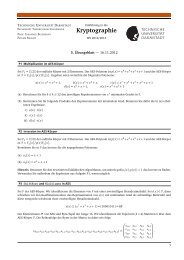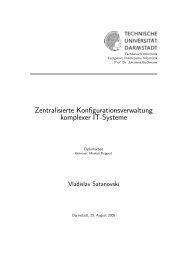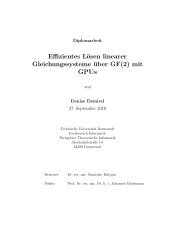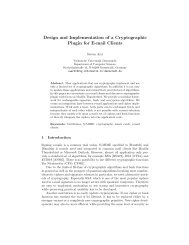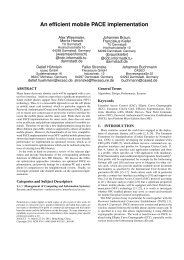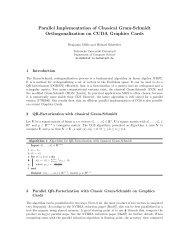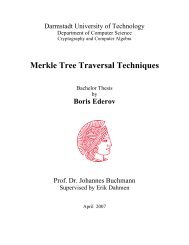Lattice Basis Reduction in Infinity Norm - Technische Universität ...
Lattice Basis Reduction in Infinity Norm - Technische Universität ...
Lattice Basis Reduction in Infinity Norm - Technische Universität ...
You also want an ePaper? Increase the reach of your titles
YUMPU automatically turns print PDFs into web optimized ePapers that Google loves.
Us<strong>in</strong>g the <strong>in</strong>troduced lower bound V , it can be seen that the <strong>in</strong>terchanges<br />
of the basis reduction algorithm is bounded above by :<br />
[m log(mUR)/ log(1/(1 − ɛ))] m<br />
The second argument for polynomiality, which achieves a different bound,<br />
depends on the observation that for a general distance function the product<br />
Fi(bi) Fi+1(bi+1) <strong>in</strong>creases by a factor ≤ 2 <strong>in</strong> any step of the algorithm<br />
for an <strong>in</strong>terchange of bi and bi+1. Here Fi(bi) = 1. Let y = bi and x =<br />
bi+1<br />
Fi(bi+1) . Fi+1(x) = 1 and F ∗<br />
dx i+1 (bi) = 1 with F ∗<br />
dx i+1 the distance function<br />
associated with a projection of the orig<strong>in</strong>al basis <strong>in</strong>to < bi, bi+2, ...., bm >.<br />
Therefore<br />
Fi(bi+1)F ∗<br />
i+1 (bi)/Fi(bi)Fi+1(bi+1) =<br />
= [ Fi(bi+1)<br />
dy<br />
]/[ Fi(bi+1)<br />
dx<br />
] = dx/dy ≤ 2<br />
Let D(b1, ...., bm) = � (Fi(bi)) γm−1,<br />
with γ = 2 +<br />
1<br />
1<br />
log( (1 − ɛ)<br />
). It is<br />
easy to see that D(b1, ...., bm) decreases by a factor of at least 1 − ɛ at each<br />
<strong>in</strong>terchange required by the basis reduction algorithm. S<strong>in</strong>ce V ≤ Fi(bi) ≤ U<br />
at each step of the algorithm , the number of <strong>in</strong>terchanges is bounded above<br />
by:<br />
[(γ m − 1)/(γ − 1)] log(U/V ) log(1/(1 − ɛ))<br />
≤ (γ n − 1)/(γ − 1)]m log(mUV ) log(1/(1 − ɛ))<br />
.<br />
This second estimate is much better than the first one <strong>in</strong> terms of its<br />
dependence to U and R. And s<strong>in</strong>ce the number of possible values of the vector<br />
F1(b1), ...., Fi(bi), Fi+1(bi+1), ...., Fm(bm) is f<strong>in</strong>ite, the basis reduction<br />
algorithm executes <strong>in</strong> f<strong>in</strong>ite time even when ɛ = 0.<br />
20





